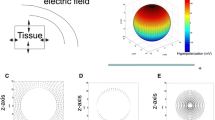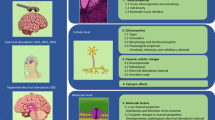Abstract
Despite several investigations and publications on possible effects due to time-varying magnetic fields, the question remains as to the magnitude of the field, or its derivative with respect to time, that is capable of stimulating the human heart. It is quite surprising how little information on cardiac stimulation has entered the discussion to date. If the law of induction and the fundamental law of stimulation, both in their field forms, are combined, the result is quite different from what has been published: (1) It is the amplitude of the gradient field that is responsible for stimulation and notdB/dt. (2) The shape of the time-varying pulse has no influence on stimulation but only its mean value. (3) Owing to different rheobase and chronaxie values for cardiac tissue and peripheral nerves, the threshold for magnetostimulation of the myocardium is up to 200-fold higher than that for nerves. These results allow for the determination of safety limits that are certainly above those proposed to date. Based on these limits, technological advancement can be achieved without neglecting the patient safety requirement.
Similar content being viewed by others
References
NRPB National Radiological Protection Board (1983) Revised guidance on acceptable limits of exposure during nuclear magnetic resonance clinical imaging.Br J Radiol 56 974–977.
McRobbie D, Foster MA (1985) Cardiac response to pulsed magnetic fields with regard to safety in NMR imaging.Phys Med Biol 30: 695–702.
Reilly JP (1989) Peripheral nerve stimulation by induced electric currents: exposure to time-varying magnetic fields.Med Biol Eng Comput 27: 101–110.
International Non-Ionizing Radiation Committee of the International Radiation Protection Association (IRPA/INIRC) (1991) Protection of the patient undergoing a magnetic resonance examination.Health Phys. 61: 923–928.
IEC/SC 62B (Secretariat) 145 (1991)Draft IEC Standard Medical Electrical Equipment. Part 2: Particular requirements for the safety of magnetic resonance systems for medical diagnosis. Geneve: Bureau Central de la Commission Electrotechnique International.
Mouchawar GA, Bourland JD, Nyenhuis JA, Geddes LA, Foster KS, Jones JT, Graber GP (1992) Closed-chest cardiac stimulation with a pulsed magnetic field.Med Biol Eng Comp 30: 162–168.
Silny J (1987) Zur Gefährdung der vitalen Funktion des Herzens im magnetischen 50Hz-Feld. Medizinisch-technischer Bericht des Instituts zur Erforschung elek-trischer Unfälle, Berufsgenossenschaft Feinmechanik und Elektrotechnik Gustav-Heinemann-Ufer 130, 50968 Köln, Germany.
Reilly JP (1992)Electrical Stimulation and Electropathology. Cambridge: Cambridge University Press.
Lapicque L (1909) Definition expérimental de l'excitabilité.Soc Biol 77: 280–283.
Irnich W (1973) Physikalische Überlegungen zur Elektro-stimulation.Biomed Technik 18: 97–104.
Irnich W (1980) The chronaxie time and its practical importance.PACE 3: 292–301.
Starmer GF, Whalen RE (1973) Current density and electrically induced ventricular fibrillation.Med Instrum 7: 3–7.
Frazier DW, Krassowska W, Chen P-S, Wolf PD, Dixon EG, Smith WM, Ideker RE (1988) Extracellular field required for excitation in three-dimensional anisotropic canine myocardium.Circ Res 63: 147–164.
Irnich W (1990) The fundamental law of electrostimulation and its application to defibrillation.PACE 13: 1433–1447.
Winfree AT (1990) The electrical thresholds of ventricular myocardium.J Cardiovasc Electrophysiol 1: 393–410.
Lepeschkin E, Jones JL, Rush S, Jones RE (1978) Local potential gradient as a unifying measure for thresholds of stimulation standstill, tachyarrythmia and fibrillation appearing after strong capacitor discharges.Adv Cardiol 21: 268–278.
Knisley StB, Smith WM, Ideker RE (1992) Effect of intrastimular polarity, reversal on electric field stimulation thresholds in frog and rabbit myocardium. JCardiovasc Electrophysiol 3: 239–254.
Weiss G (1901) Sur la possibilité de rendre comparable entre eux les appareils servant à l'excitation électrique.Arch Hal Biol 35: 413–446.
Bourland JD, Tacker WA, Geddes LA, Chafee V (1978) Comparative efficacy of damped sine wave and square wave current for transchest ventricular defibrillation in animals.Med Instrum 12: 43–45.
Tacker WA, Geddes LA (1980)Electrical Defibrillation pp. 74–85. Boca Raton, FL: CRC Press.
Wessale JL, Bourland JD, Tacker WA, Geddes LA (1980) Bipolar catheter defibrillation in dogs using trapezoidal waveforms of various tilts.J Electrocardiol 13: 359–366.
Mouchawar GA, Geddes LA, Bourland JD, Pearee JA (1989) Ability of the Lapicque and Blair strength-duration curves to fit experimentally obtained data from a dog heart.IEEE Trans. BME-36 971–974.
Reilly JP, Freeman VT, Larkin WD (1985) Sensory effects of transient electrical stimulation evaluation with a neuro-electric model.IEEE Trans BME-32 1001–1011.
Mansfield PH (1993) Limits of neural stimulation in echo-planar imaging.MRM 29: 746–758.
Kloos DA, Carstensen EL (1983) Effect of ELF electric fields on the isolated frog heart.IEEE Trans BME 30 347–348.
Irnich W (1975) Engineering concepts of pacemaker electrodes. InAdvances in Pacemaker Technology, Schaldach M, Furman S (eds). Heidelberg: Springer-Verlag.
Irnich W (1991) Engineering concepts of pacemaker leads. InPacemaker Leads 1991 Proc 2nd Int Symp on Pacemaker Leads, Ferrara Antonioli GE, Aubert AE, Ector H (eds). Amsterdam: Elsevier.
Kleinert M, Irnich W, Beer P (1977) Vergleichende Untersuchungen des Reizschwellenverhaltens nach Implantation verschieden grosser Herzschrittmacherelek-troden.Z Kardiol 66: 191–197.
Lüderitz B (1986)Herzschrittmacher, Therapie und Diagnostik kardialer Rhythmusstörungen. Heidelberg: Springer-Verlag.
Daubert IP, Frazier DW, Wolf PD, Franz MR, Smith WM, Ideker RE, (1991) Response of relatively refractory canine myocardium to monophasic and biphasic shocks.Circulation 84: 2522–2538.
Shimizu Y, Tasaki K (1966) Excitability of the developing chick embryo heart.Tohoku J Exp Med 88: 49.
Antoni H, Tägtmeyer H (1965)Die Wirkung starker Ströme auf Erregungsablauf und Kontraktion des Herztnuskels, pp. 1–21. Frankfurt: Verlags- u. Wirtschaftsges Elektrizitätswerke.
Irwin D, Rush S, Lepeschkin E, Montgomery D, Wegel R (1970) Stimulation of cardiac muscle by a time-varying magnetic field.IEEE Trans Magn M-6 321–333.
Tsukerman BM, Titomir LI (1973) Defibrillation of the heart with rotating currents.Kardiologiia 13: 75–80.
Tung L, Sliz N, Mulligan R (1991) Influence of electrical axis of stimulation on excitation of cardiac muscle cells.Circulation Res 69: 722–730.
Knisley StB, Smith WM, Ideker RE (1992) Effect of field stimulation on cellular repolarization in rabbit myocardium.Circulation Res 70: 707–715.
Milnor WR, Knickerbocker GG, Kouvenhoven WB (1958) Cardiac response to transthoracic capacitor discharges.Circulation Res 6: 60–65.
Hughes NC Jr, Tyer GFO (1975) Effect of stimulation site on ventricular threshold in dogs with heart block.Amer Heart J 89: 68–73.
Ideker RE, Krassowska W, Wharton JM, Smith WM (1989) Experimental results pertinent to the modelling of defibrillation.IEEE EngMed Biol Soc 11: 77–78.
Irnich W (1976) Elektrotherapie des Herzeus-physiologische und biotechnische Aspekte, p. 64. Berlin: Fadiverlag Schiele & Schön.
Zoll PM, Paul MH, Linenthal AJ, Norman LR, Gibson W (1956) The effect of external electric current on the heart.Circulation 14: 745–756.
Furman S, Parker B, Escher DJW (1971) Decreasing electrode size and increasing efficiency of cardiac stimulation.J Surg Res 11: 105–110.
Author information
Authors and Affiliations
Additional information
Address for correspondence: Department of Medical Engineering, Justus-Liebig-University, Gießen, Aulweg 123,35392 Gießen, Germany. Additional reprints of this chapter may be obtained from the Reprints Department, Chapman & Hall, One Venn Plaza, New York, NY 10119.
Rights and permissions
About this article
Cite this article
Irnich, W. Electrostimulation by time-varying magnetic fields. MAGMA 2, 43–49 (1994). https://doi.org/10.1007/BF01709799
Received:
Revised:
Issue Date:
DOI: https://doi.org/10.1007/BF01709799




